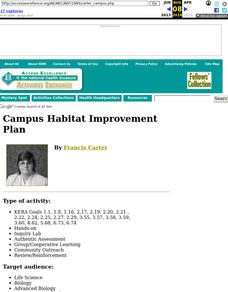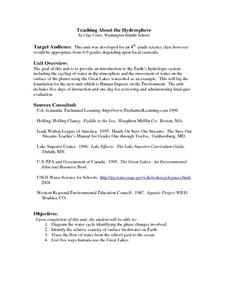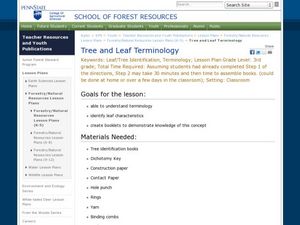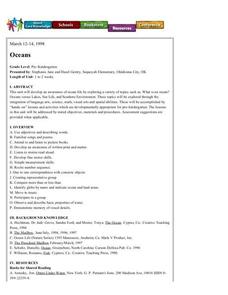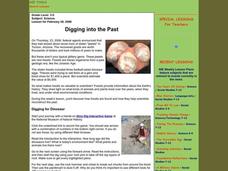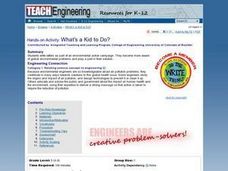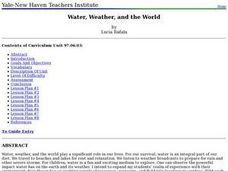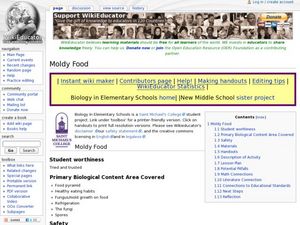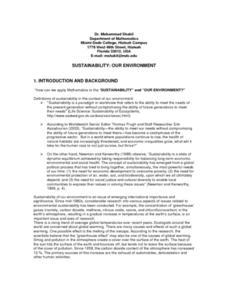Curated OER
Chocolate Asphalt Cookies
Students make no-bake cookies to learn basic engineering principles, road construction and material science. They experience properties and changes in matter.
Curated OER
The Physics of Sound: How We Produce Sounds
First graders construct a KWL chart on sound. For this physics lesson, 1st graders describe different ways to produce sound. They explain how sound waves propagate.
Curated OER
Campus Habitat Improvement Plan
Students work to improve a plot of land. They assess the needs of the environment and formulate a plan. They plant trees and gardens, build bird boxes, construct waterholes. etc.
Curated OER
Teaching About the Hydrosphere
Eighth graders are introduced to the Earth's hydrologic system including the cycling of water in the atmosphere and the movement of water on the surface of the planet using the Great Lakes watershed as an example.
Curated OER
TE Lesson: I've Gotta Get Some Air
Students investigate types and sources of indoor air pollutions both at home and in school. They decide on how to prevent poor indoor air quality. They debate smoking in order to determine how language usage can be an influence in...
Curated OER
Salt Marshes And Their Inhabitants
Young scholars investigate the ecosystem of the salt marshes. This is done in order to develop an appreciation for this type of environment. They conduct research using a variety of resources. Students are given samples of different...
Curated OER
Keeping our Water Clean
Second graders discuss how our actions impact the quality of water. In this environmental science instructional activity, 2nd graders watch a short film and discuss the problem of polluted water. Students are then divided into groups and...
Curated OER
Designing the Experiment and Answering the Question
Students investigate scientific methods by analyzing an article from the Natural Inquirer. In this data analysis lesson, students read an article from the magazine and discuss at least 2 scientific methods that could be used to solve...
Curated OER
The Open Ocean, What is it and How Does it Change?
Students investigate the ocean environment. In this ocean lesson, students discover the physical properties of the ocean. Over two days, students work in small groups investigating ocean maps and creating water currents.
Curated OER
Dangerous Air
Students investigate how pollution is a global issue. They locate the countries affected by radiation from Chernobyl, sequence the progress of radiation transport from Chernobyl and plot the pollution points on a world map, and read and...
Curated OER
TE Activity: Sound Line
Students investigate the decibel readings of various noises. They determine why high-level readings damage hearing. Students arrange sound from the lowest to highest decibel levels when they written on a piece of paper.
Curated OER
Tree and Leaf Terminology
Third graders draw leaves. In this tree and leaf identification lesson, 3rd graders find 4 or 5 trees that are on their home property and collect samples from them. Students work in groups to identify the leaves and compare those answers...
Curated OER
Oceans
Students become aware of the differences between ocean water and lake water by smelling, tasting and seeing. They distinguish between land and bodies of water on a globe and gain increased awareness of oceans and life.
Curated OER
Digging into the Past
Students discover how fossils are found and how they help scientists reconstruct the past. They examine how they shed light on what kinds of animals and plants lived over the years, when they lived, and under what environmental conditions.
Curated OER
What's a Kid to Do?
Learners participate in an environmental action letter-writing campaign. They conduct Internet research on the Global Response website, discuss various successful Global Response campaigns, select a campaign they are interested in, and...
Curated OER
Water, Weather, and the World
Students in a special education classroom examine the role of weather and water in their lives. Each day, they add a symbol for the weather outside and identify the proper activities for the weather on that day. In groups, they...
Alabama Learning Exchange
Are We Finished with It Yet?
Learners recognize the importance of natural resources and that we need to conserve, reuse and recycle them. In this conserving natural resources lesson, students are given one object and must create something with it. Young scholars...
Curated OER
Regulation of Human Heart Rate
In this regulation of the human heart rate worksheet, students learn to measure their heart rate and design an experiment to test for the affects of a stimulus on the heart rate.
Curated OER
Moldy Food
Students investigate how mold grows on food. In this mold lesson, students review the food pyramid before growing mold on different foods in Zip-Loc bags. They create graphs that show how long it takes for mold to grow on different...
Teach Engineering
Communicating Your Results
Groups analyze and interpret their data from previous research in order to develop individualized findings. The teams then use guidelines to help determine what aspects of their research to include on a poster. Class members then compare...
Curated OER
Investigative Case - Living in an Alkaline Environment
Students are shown many ways in which Mono Lake water and distilled water are different. They demonstrate that the survival of common soil bacteria declines as pH increases. Students examine the behaviors, adaptations, energy transfer,...
Curated OER
Animal Adaptations: Focus on Bird Beaks
Sixth graders explore bird beaks as animal adaptation. In this bird adaptation lesson, 6th graders conduct an experiment to determine the connection between the shape of a bird's beak and the food it eats.
Curated OER
Different Environments
Pupils read literature selection, discuss habitat, divide habitats into different categories such as water, soil, and land, list animals that live in each habitat, and describe habitats using descriptive words in vocabulary list.
Curated OER
Sustainability: Our Environment
Young scholars explore the sustainability of our environment, the trend in rising temperatures and the emission of greenhouse cases. Using given data, students test and construct a confidence interval and the difference between two...




